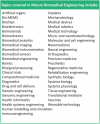BME 2.0: Engineering the Future of Medicine
- PMID: 37849657
- PMCID: PMC10530648
- DOI: 10.34133/bmef.0001
BME 2.0: Engineering the Future of Medicine
Abstract
If the 20th century was the age of mapping and controlling the external world, the 21st century is the biomedical age of mapping and controlling the biological internal world. The biomedical age is bringing new technological breakthroughs for sensing and controlling human biomolecules, cells, tissues, and organs, which underpin new frontiers in the biomedical discovery, data, biomanufacturing, and translational sciences. This article reviews what we believe will be the next wave of biomedical engineering (BME) education in support of the biomedical age, what we have termed BME 2.0. BME 2.0 was announced on October 12 2017 at BMES 49 (https://www.bme.jhu.edu/news-events/news/miller-opens-2017-bmes-annual-meeting-with-vision-for-new-bme-era/). We present several principles upon which we believe the BME 2.0 curriculum should be constructed, and from these principles, we describe what view as the foundations that form the next generations of curricula in support of the BME enterprise. The core principles of BME 2.0 education are (a) educate students bilingually, from day 1, in the languages of modern molecular biology and the analytical modeling of complex biological systems; (b) prepare every student to be a biomedical data scientist; (c) build a unique BME community for discovery and innovation via a vertically integrated and convergent learning environment spanning the university and hospital systems; (d) champion an educational culture of inclusive excellence; and (e) codify in the curriculum ongoing discoveries at the frontiers of the discipline, thus ensuring BME 2.0 as a launchpad for training the future leaders of the biotechnology marketplaces. We envision that the BME 2.0 education is the path for providing every student with the training to lead in this new era of engineering the future of medicine in the 21st century.
Copyright © 2023 Michael I. Miller et al.
Figures







References
-
- Cepelewicz J. The U.S. government launches a $100-million “Apollo Project of the Brain”: Intelligence project aims to reverse engineer the brain to find algorithms that allow computers to think more like humans. Scientific American, Neuroscience. 8 Mar 2016. https://www.scientificamerican.com/article/the-u-s-government-launches-a...
-
- Harari YN. Homo deus: A brief history of tomorrow. New York: Harper Collins; 2017.
-
- Metzl J. Hacking Darwin: Genetic engineering and the future of humanity. 1st ed. Sourcebooks; 2019.
-
- The Economist. The third industrial revolution. 21 Apr 2012. https://www.economist.com/leaders/2012/04/21/the-third-industrial-revolu...
Publication types
Grants and funding
LinkOut - more resources
Full Text Sources

